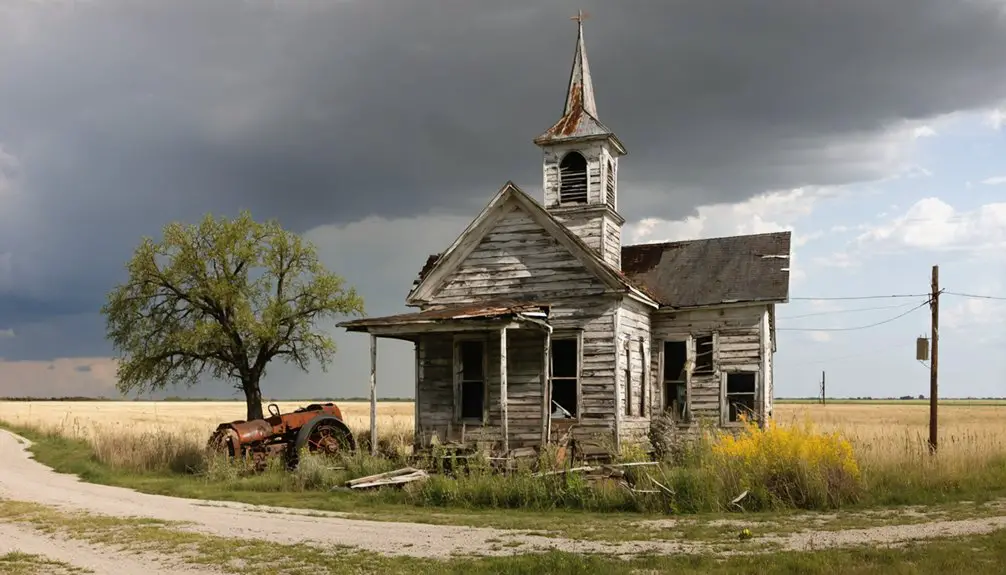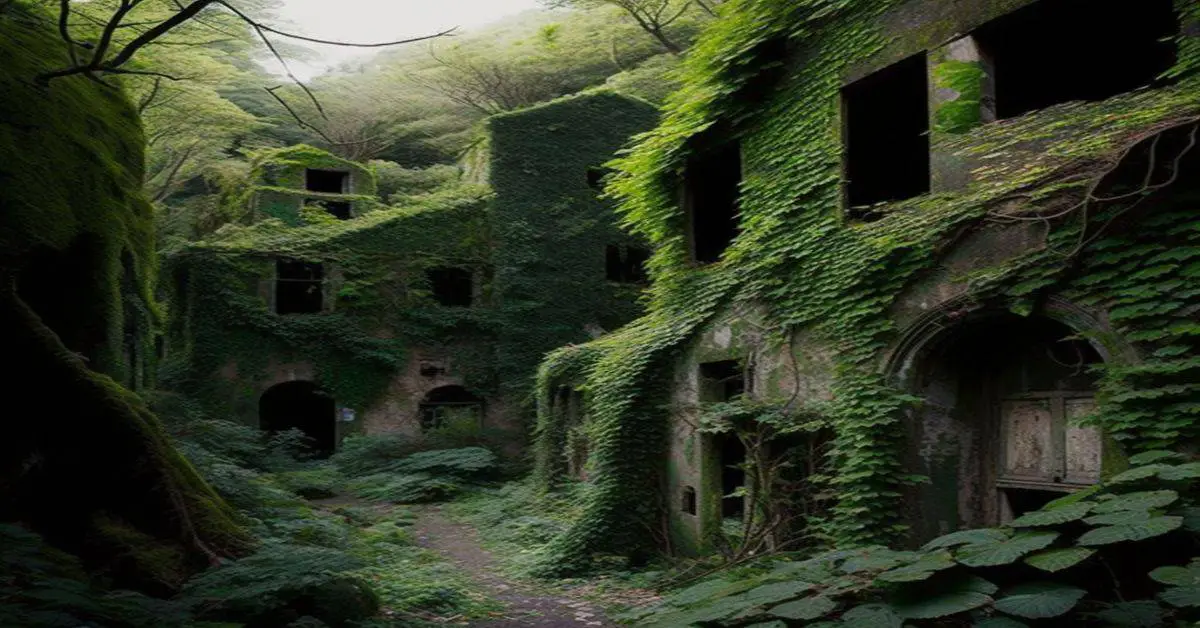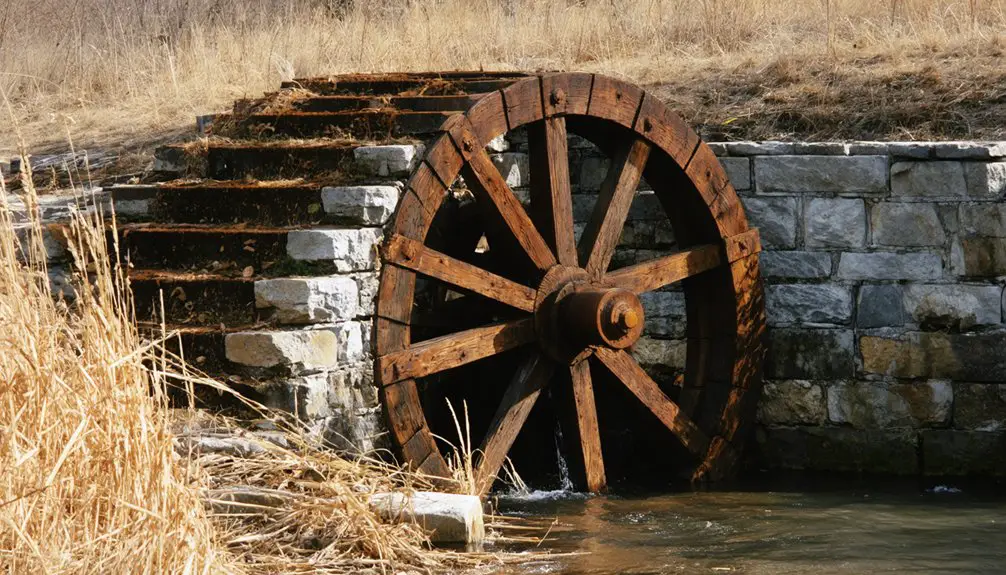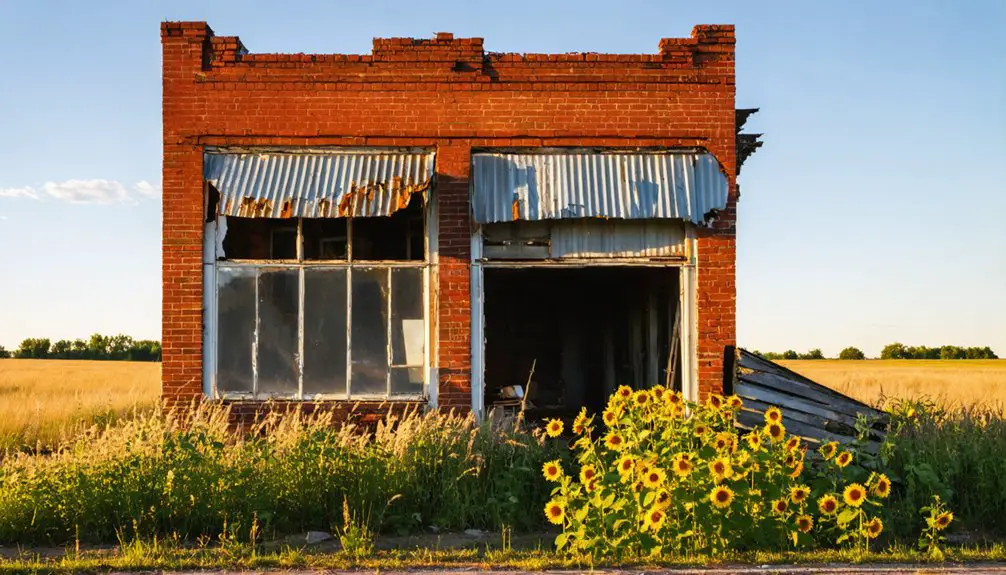You’ll find Miller’s ghost town remnants in Lyon County, Kansas, where Irish immigrant Thomas Condell established a 5,000-acre cattle ranch in 1868. After Condell’s death in 1880, the William and Hiram Miller brothers purchased and expanded it to 10,000 acres, adding a canning company and circus attractions. Today, scattered architectural remains, weathered barns, and the Miller Cemetery offer glimpses into this once-thriving ranching community’s fascinating journey through boom and bust.
Key Takeaways
- Miller was established in 1868 by Thomas Condell and later expanded by the Miller brothers to a 10,000-acre ranch in Lyon County, Kansas.
- The town experienced significant decline during the Great Depression, leading to business closures and population loss in the community.
- Historic structures include deteriorating homesteads, weathered barns, and the Miller Cemetery containing prominent early settler graves.
- The Miller Brothers Circus and rodeo events, including a 10,000-seat arena, contributed to the town’s cultural significance before decline.
- Current preservation efforts are transforming the ghost town into a living historical community through volunteer work and documentation initiatives.
The Origins of Miller Ranch: Thomas Condell’s Vision
In 1868, Irish-born Thomas Condell from Illinois commenced an ambitious venture by purchasing over 5,000 acres in Lyon County, Kansas, to establish Miller Ranch.
You’ll find that Condell’s aspirations extended beyond mere land ownership – he envisioned creating a profitable cattle operation that would secure his family’s future in the expanding Kansas frontier.
As part of his ranch management strategy, Condell sent his sons to oversee the cattle operations, aiming to capitalize on the lucrative markets in Kansas City.
His initial investment demonstrated remarkable foresight in recognizing the region’s agricultural potential.
However, his dreams of expansion faced an unexpected setback when one of his sons betrayed his trust, selling cattle and disappearing with the proceeds.
In a cruel twist of fate, paternal trust crumbled when his son absconded with profits from unauthorized cattle sales.
Similar to how the Falfurrias Facts kept local residents informed, word of the ranch’s troubles spread quickly throughout the community.
This devastating turn of events would greatly impact the ranch’s trajectory, forcing Condell to relocate to Lyon County to personally manage the remaining operations.
From Financial Troubles to New Ownership
After Thomas Condell’s death in 1880, financial troubles plagued Miller Ranch as mounting debts and mortgages threatened its survival. The ranch’s financial management had suffered due to earlier setbacks, including a betrayal by Condell’s son that led to the property being mortgaged in 1877. Like many Kansas properties during the severe winter of 1855-1856, the ranch had endured significant hardships that contributed to its ongoing financial strain. Devastating fires in early 1900s caused widespread damage throughout the region, creating additional challenges for the community.
You’ll find that fortunes began to change in 1881 when the mortgage was finally paid off. The following year, William and Hiram Miller purchased the ranch from Condell’s heirs, ushering in an era of significant ranch expansion. Under their ownership, the estate grew to an impressive 10,000 acres.
The Millers didn’t stop there – they diversified their investments by establishing the Miller Canning Company in 1917, which provided essential employment opportunities for local families during challenging economic times.
The Miller Brothers’ Golden Era
After purchasing 10,000 acres from the Condell heirs in 1882, they’ve steadily expanded their influence beyond traditional ranching into groundbreaking entertainment ventures.
The ranch’s success came after G.W. Miller’s death in 1903, when his sons relocated operations from Winfield to Bliss, Oklahoma.
Following their father’s legacy, they created Miller Brothers Circus in 1937, starting with just two monkeys and four ponies.
- Launched annual rodeo round-ups in 1904 with a 10,000-seat arena
- Created the 101 Ranch Great Far East and Real Wild West Show in 1925
- Operated 30 new steel railroad cars, including a private family car
- Established official world championship rodeo contests in 1924
- Developed the Miller Brothers’ Circus in 1937, featuring over 50 elephants
Their ambitious vision helped establish Ponca City as a cultural hub, while their entertainment ventures attracted national attention.
The Millers’ innovative vision elevated a small Oklahoma town into a renowned destination for Western entertainment and cultural attractions.
Through politics and performance, they’ve created a legacy that’s transformed their property into more than just a working ranch.
Life in Early Miller Settlement
Life on the frontier settlement of Miller, Kansas began in 1868 when Thomas Condell, an Irish immigrant from Illinois, purchased 5,000 acres of Lyon County ranchland.
You’d have found a sparse population of ranch hands and family members managing vast herds of cattle across the remote terrain.
Early challenges struck when Condell’s son absconded after selling cattle, forcing the family to mortgage their holdings.
Daily hardships included grueling manual labor, isolation from nearby settlements, and the constant pressure of maintaining a profitable ranching operation.
Like many settlers, they relied on homesteading through veterans claims to establish their presence in the area.
Like Daniel Miller in 1855, the early settlers faced significant challenges establishing themselves in the Kansas territory.
You wouldn’t have found many amenities here – no schools, churches, or businesses emerged beyond the basic ranch structures.
The settlement’s focus remained solely on cattle management, with regular drives to Kansas City markets determining the community’s economic survival.
Natural Disasters and Town Struggles
While records don’t show specific natural disasters affecting Miller, Kansas, you’ll notice that the town faced other significant challenges during its decline.
Like many Kansas settlements that faced destructive floods, Miller’s vulnerability to environmental challenges was a constant concern for early settlers.
Similar to Orchard and Potosi, Miller’s remote location and lack of documented weather events suggest that environmental factors weren’t primary contributors to its ghost town status.
The town’s remote location and lack of documented weather events suggest that environmental factors weren’t primary contributors to its ghost town status.
Instead, you’ll find that economic hardships, particularly those stemming from Thomas Condell’s financial setbacks, played a more decisive role in the town’s struggles.
Fire Devastation Through History
Throughout Miller’s early history, devastating fires repeatedly threatened the town’s survival, particularly during the 1900s when no local fire department existed. The lack of fire prevention infrastructure made the community especially vulnerable, leading to considerable property losses and stunted growth.
Key fire incidents that shaped Miller’s history include:
- Early 1900s widespread destruction of multiple buildings before fire department formation
- 1916 partial destruction of a prominent manor house, later remodeled into a farm home
- January 16, 1956 grade school fire incident detected near the chimney
- Recurring damage to churches, hotels, and homes throughout various periods
- Eventual establishment of local fire department showcasing community resilience
These destructive events, combined with other natural disasters, contributed considerably to Miller’s eventual decline into a ghost town, despite repeated rebuilding efforts by determined residents.
Economic Impact of Disasters
The devastating fires that plagued Miller were just one component of broader economic catastrophes that battered the town’s survival prospects.
You’ll find that Miller’s economic resilience was tested repeatedly, from the destruction of essential infrastructure like the Huron flouring mill in 1865 to the devastating floods along the Cottonwood River. The Great Depression dealt another crushing blow, severely limiting the community’s recovery options when natural disasters struck.
Each setback triggered a chain reaction – businesses closed, populations relocated, and land ownership shifted to outside investors.
You can trace this pattern through the Miller Ranch’s history, where Thomas Condell’s financial troubles following his son’s theft led to multiple ownership changes. These combined pressures ultimately proved too much for Miller’s fragile frontier economy to withstand.
Weather-Related Structural Damage
As severe storms lashed the Kansas plains, Miller endured a relentless barrage of natural disasters that systematically dismantled its structural foundation.
The town’s weather patterns brought devastating forces that tested its structural resilience at every turn.
- Tornadoes with intensities up to F5 ripped through the region, flattening homes and municipal buildings.
- The 1931 Missouri-Pacific freight train derailment destroyed Miller’s depot during harsh weather conditions.
- Catastrophic floods, like the 1951 Cottonwood River disaster, submerged entire towns under five feet of water.
- Fire incidents ravaged critical structures including general stores and one-room schoolhouses.
- Lightning strikes and high winds repeatedly compromised utility infrastructure and power lines.
These destructive forces ultimately proved too much for Miller’s aging buildings and infrastructure, contributing to the town’s eventual decline.
The Great Depression’s Impact
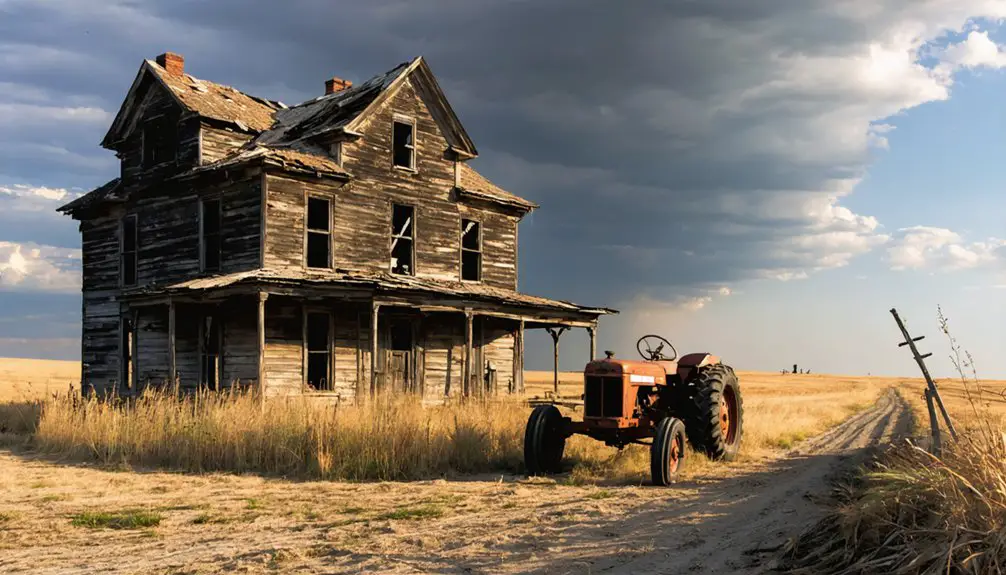
During the 1930s, Miller’s economic importance crashed as the Great Depression paralyzed local businesses and devastated the farming community. You’d have witnessed plummeting demand across all sectors, with Miller Ranch and other agricultural operations struggling against deflated market prices.
Like countless rural towns, Miller’s spirit withered under the Great Depression’s merciless grip on farms and businesses.
The town’s prospects for economic recovery dimmed as the Miller Bank merged with Admire’s bank in 1941, leaving residents with limited financial services.
The Depression’s grip triggered widespread rural migration as families abandoned their farms and businesses in search of opportunities elsewhere. You’d have seen the town’s liveliness drain away as local enterprises failed or relocated, while restricted access to loans and banking services prevented any meaningful reinvestment.
This economic stagnation ultimately contributed to Miller’s extinction, marking the end of a once-thriving Kansas community.
Notable Characters Who Shaped Miller
You’ll find Thomas Condell’s ambitious 1868 purchase of 5,000 acres marked Miller’s earliest pioneering legacy, though his dreams faltered when his son absconded with cattle profits.
The property’s sale to William and Hiram Miller in 1882 ushered in a new era of prosperity, as the brothers expanded the ranch operations considerably.
Under Hiram Miller’s leadership as a prominent Kansas politician and banker, the ranch grew to nearly 10,000 acres while establishing Miller as an essential economic hub in Lyon County.
Thomas Condell’s Pioneering Legacy
While many pioneers shaped Lyon County’s early development, Thomas Condell left an indelible mark on the region’s ranching history when he purchased over 5,000 acres of land in 1868.
You’ll find his story reflects the true spirit of frontier independence, though it’s marked by both triumph and hardship in northeast Kansas.
- Established one of the largest private ranches in Lyon County
- Entrusted his sons with ranch management, leading to a devastating betrayal when one sold cattle and fled
- Took personal control of operations after the betrayal but struggled to maintain his passion
- Faced mounting financial pressure, resulting in a mortgage by 1877
- Passed away in 1880, leaving a legacy that would transform into the Miller Ranch
Condell’s challenges with ranch management ultimately led to his heirs selling the property to the Millers in 1882, forever changing the area’s future.
Miller Brothers’ Ranch Empire
The transformation of Condell’s former holdings began in 1881 when Colonel George Washington Miller established the legendary 101 Ranch brand in Kansas.
You’ll find Miller Ranch’s early innovations revolutionized the cattle industry, as it was among the last operations to shift from open-range drives to fenced ranching.
After moving to Oklahoma in the 1890s, the ranch expanded to over 100,000 acres.
When Colonel Miller died in 1903, his three sons – Joe, Zack, and George Lee – took the reins.
Each brother brought unique talents: Joe managed farming operations, Zack developed the famous Wild West shows, and George Lee oversaw livestock.
Under their leadership, the ranch became America’s greatest diversified operation, featuring everything from cattle and bison to wheat fields and a cannery.
Their ranching innovation transformed a simple cattle operation into a self-sufficient empire.
Agricultural Legacy and Ranching Heritage

As Irish immigrant Thomas Condell purchased over 5,000 acres in 1868, Miller’s agricultural legacy took root in northeast Lyon County, Kansas. His vision for cattle ranching shaped the region’s early development, showcasing remarkable community resilience through challenging frontier conditions.
Through grit and determination, Thomas Condell’s Irish roots gave rise to a Kansas ranching empire that transformed Lyon County forever.
You’ll find Miller’s rich ranching heritage reflected in these crucial developments:
- The ranch’s expansion to 10,000 acres under the Miller brothers demonstrated agricultural innovations in land management.
- Large-scale cattle drives to Kansas City markets established essential trade routes.
- Local ranching families wielded significant influence in regional politics and banking.
- The ranch’s operations drove infrastructure development and economic growth.
- Advanced livestock management practices set standards for future generations.
Despite eventual decline, Miller’s agricultural legacy exemplifies the pioneering spirit that transformed Kansas’s rural landscape.
Architectural Remains and Historical Sites
Standing amid the Kansas prairie today, you’ll find scattered architectural remnants of Miller’s once-thriving ranching community, including deteriorating homesteads, weathered barns, and crumbling ranch outbuildings from the late 19th century.
The architectural significance of these structures tells the story of the Miller Ranch’s expansion from its 1868 founding to its peak of 10,000 acres under the Miller brothers’ ownership.
The Miller Cemetery stands as the best-preserved historical site, featuring prominent headstones of early settlers like Irish immigrant Arch Miller, born in 1834.
Early 1900s fires devastated much of the town’s architectural heritage, accelerating its decline into ghost town status.
While no intact commercial buildings remain, the historical preservation of ranch foundations and cemetery markers provides glimpses into Miller’s agricultural golden age.
Modern Preservation Efforts and Community Spirit
Modern-day Miller owes its survival to a dedicated core of residents who’ve transformed this ghost town into a living historical community.
You’ll find remarkable community engagement through active preservation efforts, despite the preservation challenges of maintaining a historic site with limited resources.
Local residents guarantee Miller’s legacy continues through:
- Maintaining a well-equipped fire department, learning from early 1900s vulnerabilities
- Documenting the town’s history through oral histories and regional archives
- Performing volunteer-led repairs on buildings, pathways, and infrastructure
- Supporting responsible heritage tourism that respects historic sites
- Collecting and preserving records of Miller’s past for educational programs
This grassroots dedication keeps Miller’s story alive, proving that even small communities can maintain their historical identity through collaborative stewardship.
Frequently Asked Questions
What Kind of Wildlife Was Common Around Miller During Its Peak Years?
You’d have found incredible wildlife diversity around Miller, from white-tailed deer and coyotes to bobcats and foxes. Hunting practices focused on wild turkeys, while beavers thrived along nearby streams.
Were There Any Native American Settlements in the Miller Area Before 1868?
You’ll find no permanent Native American tribes settled directly in Miller before 1868, though Kanza and other tribes actively used the area for hunting and passed through along nearby waterways.
Did Any Famous Outlaws or Lawmen Ever Pass Through Miller?
You won’t find any documented outlaw encounters or lawman stories in Miller’s history. The rural ranching area, centered around Miller Ranch after 1882, remained outside the paths of Kansas’s notorious figures.
What Was the Highest Recorded Population of Miller During Its History?
Despite limited population growth in rural Kansas settlements, historical records show Miller’s highest recorded population was 24 residents in 1910, and you’ll find that’s less than a quarter of typical ghost towns.
Were There Any Significant Mineral Discoveries or Mining Operations Near Miller?
You won’t find records of significant mineral discoveries or mining operations near Miller. While mineral exploration and mining techniques were common in nearby areas like Minersville, Miller didn’t develop around mining activities.
References
- https://legendsofkansas.com/miller-kansas/
- https://www.legendsofamerica.com/huron-kansas/
- https://www.youtube.com/watch?v=PfThSLZOtqg
- https://www.youtube.com/watch?v=QR7F4iJcE0w
- https://www.youtube.com/watch?v=kPPeKY1mlzc
- https://www.ksre.k-state.edu/historicpublications/pubs/Ext_Hist_v_III_index.pdf
- https://texashistory.unt.edu/ark:/67531/metapth869514/m1/3/
- https://sites.rootsweb.com/~kssalihp/churches/historyofmethodism.html
- https://clinicaltrials.gov/study/NCT05987241?tab=history&a=146
- https://legendsofkansas.com/period-of-violence/
